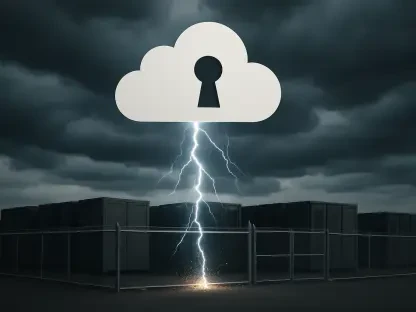The idea of end-to-end encryption (E2EE) in cloud storage systems is meant to inspire confidence, informing users that their data is protected from unauthorized access. However, recent analysis by cybersecurity researchers Jonas Hofmann and Kien Tuong Truong from ETH Zurich places this notion under intense scrutiny. Key vulnerabilities in the E2EE systems of five prominent cloud storage providers—Sync, pCloud, Icedrive, Seafile, and Tresorit—present substantial security risks.
Understanding End-to-End Encryption and Its Importance
The Role of E2EE in Cloud Storage Security
End-to-end encryption is deemed the gold standard for data security, ensuring that data is encrypted on the user’s device and remains encrypted until it reaches its destination. This theoretically prevents anyone, including service providers, from accessing the content. Users rely on E2EE to safeguard sensitive information like personal documents, financial records, and confidential communications stored in the cloud. The security promise of E2EE is particularly appealing in a time where data breaches are increasingly common, and the stakes for personal and corporate information integrity are higher than ever.
Given the digital age we live in, the integrity and confidentiality provided by E2EE are more critical than ever. Trusting cloud providers with sensitive data comes with the assumption that these service providers cannot decode the information even if they wanted to. This level of security adds a vital layer of protection against potential cyber threats. However, the recent research by Hofmann and Truong shatters this illusion by revealing gaping vulnerabilities in the E2EE implementations of popular cloud storage services.
Promises vs. Reality
Despite the theoretical robustness of E2EE, Hofmann and Truong’s findings suggest that the actual implementation by major providers leaves significant gaps. These loopholes mean that if the server infrastructure is compromised, attackers could potentially decrypt data, tamper with files, or even inject malicious data. This stark gap between promise and actual security forms the crux of the problem. Such revelations point to a severe disconnect between the intended benefits of end-to-end encryption and the current reality posed by flawed implementation, making it clear that simply having E2EE is not enough.
The research brings to light how these encryption promises fail when confronted with a sophisticated threat environment. The vulnerabilities exposed indicate not just oversights but fundamental flaws in how these cloud storage providers have set up their cryptographic safeguards. This unsettling insight compels a reevaluation of what E2EE is supposed to deliver and how well it actually performs under realistic threat scenarios, shaking the very foundation of user trust in these services.
Critical Vulnerabilities Uncovered
Sync and pCloud: Exposing Confidentiality and Integrity Risks
The researchers uncovered that both Sync and pCloud are vulnerable to severe risks if their servers are compromised. Attackers can inject new files, alter existing ones, and access uploaded files in plaintext. These breaches not only expose confidential data but also threaten the integrity and authenticity of stored information, posing a significant risk to users. In essence, an attacker with server access can manipulate the data flow, undermining the very purpose of encryption by making alterations that the end user would assume came from a legitimate source.
Sync and pCloud’s vulnerability to server tampering reveals a broader issue within the E2EE framework: the dependence on server integrity. As long as the server remains an Achilles’ heel, no amount of data encryption can guarantee safety. These findings emphasize that the sophistication of an attacker’s tools and strategies can easily outpace the defensive measures employed by these cloud providers, prompting a needed shift in focus toward more resilient security protocols that can withstand such invasions.
Seafile and Brute-Force Risks
In Seafile, weaknesses were found in how encryption metadata is managed. Hackers can manipulate this information to accelerate brute-force attacks, increasing the chances of successfully accessing plaintext data. Brute-force attacks, wherein a hacker tries numerous combinations to crack an encryption key, are made significantly easier when encryption metadata is not properly safeguarded. This vulnerability not only heightens the risk of data breaches but also questions the robustness of Seafile’s entire cryptographic framework. Furthermore, the tampering potential further highlights systemic flaws in securing stored content even under encryption.
The implications of this flaw extend beyond just brute-force accelerations; they hint at broader cryptographic oversights that could be exploited in multiple ways. Managing encryption metadata correctly is crucial to maintaining the secrecy and integrity of encrypted data. Seafile’s issues expose how deeply ingrained these vulnerabilities can be, making them a focal point for attackers and a critical area for providers to address. Without immediate corrective actions, such vulnerabilities undermine the very essence of end-to-end encryption, rendering it ineffective against sophisticated cyber threats.
Server Compromise: A Realistic and Severe Threat
Why Server Compromises are Highly Plausible
The analysis asserts that server compromises are not hypothetical scenarios but realistic threats in the current cybersecurity landscape. Sophisticated threat actors, including nation-state hackers, often target high-value cloud storage systems to access sensitive data. With increasing reports of state-sponsored hacking efforts, the potential for such actors to compromise servers and exploit weaknesses in E2EE systems becomes ever more plausible. This potential makes it imperative for providers to bolster their defenses beyond basic encryption promises. The acknowledgment that servers can and do get compromised challenges the cloud industry’s current defensive postures, urging a more aggressive stance on security.
Server compromises are particularly concerning due to the cascading impact they can have on otherwise secure systems. Once a server is infiltrated, the attacker gains a strategic advantage, enabling a host of malicious activities such as injecting rogue files, modifying data, and even decrypting securely encrypted content. This points to a need for a paradigm shift in how security is approached, emphasizing a more holistic and layered approach that goes beyond traditional firewalls and intrusion detection systems.
Potential Impact and Fallout
The consequences of a server compromise are far-reaching—beyond just data leakage, it can lead to widespread loss of trust, legal repercussions, and significant financial damage. For organizations and individuals who depend on these cloud services for secure storage, the stakes are incredibly high. A single breach can trigger a domino effect, exposing sensitive information and causing lasting damage. This erosion of trust can lead to a loss in customer base, harming the business’s reputation and, consequently, its profitability. From a legal standpoint, companies could face sanctions and hefty fines if found to be in violation of regulations like GDPR or CCPA, which mandate stringent data protection norms.
The financial implications of such breaches are not limited to immediate losses but can extend to long-term damages, including legal fees, compensation for affected customers, and the cost of rectifying security oversights. The potential for brand damage and loss of customer confidence amplifies the need for robust security measures that go beyond marketed promises. Importantly, this scenario highlights the critical necessity for cloud storage providers to adopt a more proactive approach to security, anticipating potential threats before they materialize and implementing comprehensive measures to mitigate risks effectively.
A Close Look at Provider Responses
Sync, Seafile, and Tresorit: Acknowledgement and Steps Forward
Upon discovering the vulnerabilities, Sync, Seafile, and Tresorit have acknowledged the issues highlighted in the research. While acknowledgment is a crucial first step, it remains to be seen how effectively these companies will implement fixes and whether these enhancements will address the deeper, systemic flaws revealed. Acknowledging the problem is only the beginning; the success of these providers will depend on their ability to devise and deploy robust solutions that can withstand sophisticated attacks. Their readiness to collaborate with cybersecurity experts and their commitment to continual improvement will be critical factors in regaining and maintaining user trust.
These providers’ willingness to accept and work on these vulnerabilities sets them apart and can pave the way for substantial improvements in their security postures. However, it also places them under the scrutiny of both the public and cybersecurity experts, who will be eagerly awaiting tangible outcomes. The actions they take going forward will serve as a benchmark for the entire industry, illustrating whether true security and user protection can be effectively balanced with usability and convenience.
pCloud and Icedrive: Silence and Concerns
In contrast, pCloud and Icedrive have yet to respond to the identified vulnerabilities. This lack of response is concerning as it delays potential mitigation efforts and leaves users exposed to known threats. Provider transparency and prompt action are critical in maintaining user trust and system integrity. The silence from these providers casts a shadow over their commitment to security, potentially eroding user confidence and raising concerns about the broader industry response to such critical vulnerabilities. It underscores the importance of accountability and the need for all providers to take active roles in addressing these significant security concerns.
The longer pCloud and Icedrive delay their response, the more vulnerable their user base remains. This inaction not only jeopardizes user data but also risks long-term reputational damage as customers may begin seeking more reliable and transparent alternatives. Their current silence could also signal a broader issue within the company culture or capabilities, where recognizing and acting upon security risks is not prioritized. This scenario accentuates the necessity for a more standardized approach to vulnerability management in the industry, encouraging prompt, transparent communication, and action.
Broader Implications for the Industry
Common Cryptographic Failures
The analysis indicates that the vulnerabilities are not isolated but part of a broader, systemic issue inherent in how these providers implement their cryptographic protections. The recurring themes of file tampering and access to plaintext data signal common failure points that need industry-wide attention. It appears that multiple providers have fallen into similar pitfalls in their encryption strategies, highlighting a need for more robust and universally acceptable cryptographic protocols. This systemic issue points to an overarching problem in the industry’s approach to implementing and maintaining end-to-end encryption standards, raising questions about the reliability of current security measures.
The existence of such widespread vulnerabilities suggests that these issues extend beyond individual companies’ negligence or oversight. They indicate a critical need for a review and overhaul of the cryptographic practices employed across the cloud storage industry. Ensuring the integrity and confidentiality promised by E2EE requires not just patching up individual leaks but fundamentally rethinking how these systems are designed, implemented, and maintained to withstand evolving cyber threats.
Balancing Utility and Security
One of the primary reasons for these vulnerabilities is the trade-off between usability and robust security measures. Achieving a seamless user experience often means compromising on certain security elements, which sophisticated attackers can exploit. This compromise sets a dangerous precedent where convenience outweighs security. While user-friendly interfaces and features are essential for widespread adoption, they should not come at the expense of weakening the overall security framework. This balance between utility and security needs to be recalibrated to prioritize the robust protection of user data.
Successfully balancing utility and security will require a collaborative effort between service providers, cybersecurity experts, and the user community. It’s essential to develop encryption protocols and security measures that do not force users to choose between convenience and safety. By fostering a culture that prioritizes security without compromising on usability, the industry can create resilient systems that protect data while offering the seamless experience users expect. This balanced approach will be critical in ensuring long-term trust and reliability in cloud storage services.
Looking Ahead
The Path to Enhanced Security
For cloud storage providers, addressing these vulnerabilities requires re-evaluating their cryptographic protocols and strengthening server defenses. Moving forward, collaboration with cybersecurity experts and adopting community-vetted standards could help mitigate these risks. Implementing stronger, more resilient encryption methods is essential, but these must be complemented by robust server security measures. Such a comprehensive approach will ensure that even if a server is compromised, the damage can be contained and user data remains protected.
Additionally, these providers should regularly conduct security audits and vulnerability assessments, engaging independent cybersecurity firms to identify and address potential weaknesses preemptively. The key lies in fostering an ongoing culture of security awareness and vigilance, where proactive measures and continual improvements become standard practice. This approach not only addresses current vulnerabilities but also builds resilience against future, more sophisticated threats, gradually restoring user confidence in the robustness of E2EE systems.
User Awareness and Protective Measures
End-to-end encryption (E2EE) in cloud storage is designed to assure users that their data is safe from unauthorized access. This concept promises that files are encrypted on the user’s device and only decrypted by the intended recipient. Despite this promise, cybersecurity experts Jonas Hofmann and Kien Tuong Truong from ETH Zurich have conducted a thorough investigation that challenges this assurance. Their in-depth research highlights significant vulnerabilities in the E2EE systems of five major cloud storage providers: Sync, pCloud, Icedrive, Seafile, and Tresorit.
These findings are alarming, revealing that even with E2EE, sensitive data stored with these providers might not be as secure as users believe. The vulnerabilities could potentially allow attackers or unauthorized parties to access data that should be fully encrypted and thus, inaccessible. This analysis suggests that the perceived security of E2EE cloud storage could be misleading, urging users to reconsider how they store and protect their sensitive information. As more individuals and businesses rely on cloud storage, understanding these risks is crucial for maintaining data privacy and security.









